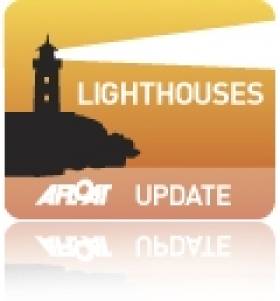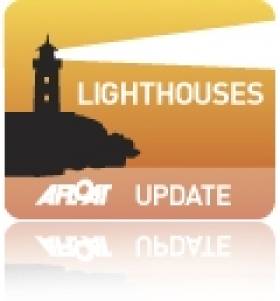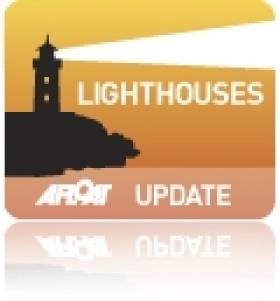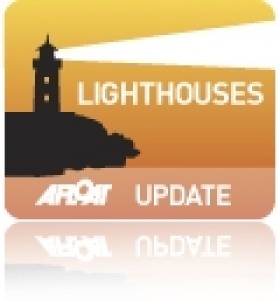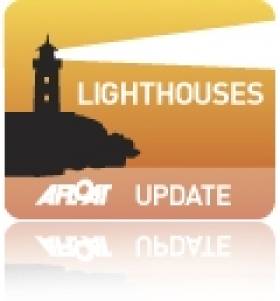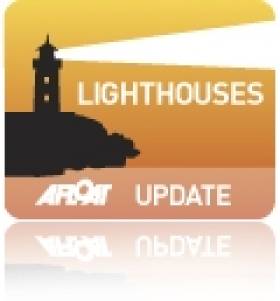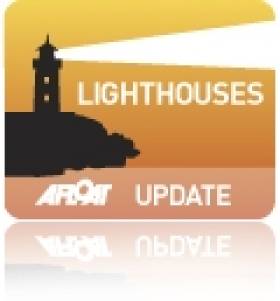Displaying items by tag: lighthouses
New LED Light on Inisheer and Exhibition of Old Plassy Wreck
#PlassyWreckExhibition- As previously reported on Afloat.ie, Inisheer Lighthouse on the easternmost of the Aran Islands, was installed with a new light emitting diode (LED) light by the Commissioners of Irish Lights (CIL) last month.
The Iighthouse is a highly important Aid to Navigation (AtoN) as this safeguards the considerable traffic between Inisheer and Co. Clare. It also marks the south-eastern end of the Aran Islands and the western side of the southern approach route to Galway Bay.
It stands 34 metres and this is to ensure visibility of the light due to the low-lying nature of the Island. A red sector of the light delineates the potential danger of Finnis Rock lying to the east.
As previously reported on Afloat.ie, it was during a passage of the Plassy, a Limerick Steamship Co. owned general cargoship which ran aground in a severe storm off Finnis Rock in 1960.
The wreck of the vessel is of TV 'Father Ted' fame, having featured in the opening credits and is the theme for an exhibition 'Art of Rust – From Rust to Art' which this afternoon opens (from 5pm till 7pm) in the National Maritime Museum of Ireland (NMMI) Dun Laoghaire.
#FinnishBuoys – Finnish state-owned company Meritaito Ltd, originally Finnish Maritime Administration are joining forces with Commissioners of Irish Lights on testing of 'spar' buoys normally used in Baltic Sea ice-flows and not the Irish Sea, writes Jehan Ashmore.
Meritaito which specialises in the maintenance and development of waterways and marine infrastructure are to carry out performance and survivability tests on spar buoys as part of the Dublin Bay Digital Diamond (see interactive map) from new-look CIL website.
Finland has to contend and experience icy waterway conditions and so they have developed the Spar buoys which are of a slimmer 'tube' structure design. This design has enabled easier conditions better suited for dealing with ice-flows.
Despite the particular suitability of design, they can suffer from conspicuity problems when compared to their Irish counterparts in the use of conventional buoys.
CIL's aids to navigation tender ILV Granuaile, based at her homeport HQ in Dun Laoghaire Harbour, is scheduled to deploy the spar buoys later this late summer.
The two spar buoys, one cardinal, the other lateral, are to be deployed in close proximity to the Bennet Bank off the eastern fringes of Dublin Bay and the West Blackwater buoy which is on the Irish Sea.
Take A Virtual Tour Of Hook Head Lighthouse
#Lighthouses - The world's oldest operational lighthouse is worth a visit for any tourists in the Sunny Southeast, but now anyone can take a virtual tour of the Hook Head lighthouse from the comfort of their own home - or anywhere, if you're using a laptop!
Placed at the top of Lonely Planet's list of the 'Top 10 Flashiest Lighthouses', the Hook Head light has been opened to the public as a tourist attraction each year since 2001, and is a great spot for watching whales and dolphins.
Now the breathtaking view afforded from the top of this towering fixture of the Wexford coastline can be seen from anywhere in the world. Click HERE to see for yourself!
Worker Left Dangling From NI Lighthouse Rescued
#Lighthouses - TheJournal.ie reports on the rescue of a repairman left dangling 40 feet in the air from the side of a lighthouse in Northern Ireland after the scaffolding he was standing on collapsed.
The NI Ambulance Service tweeted this image of the worker's precarious situation at St John's Point Lighthouse near Donwpatrick yesterday (14 March).
Thankfully the man was rescued shortly after with no serious injuries sustained.
See the dizzying predicament for yourself:
Scene from this mornings rescue at St Johns point. Patient can be seen suspended from rope and scaffolding collapsed pic.twitter.com/L43hdERJtQ
— NIAS (@NI_Amb_Service) March 14, 2014Lectures: Baily Lighthouse - A Shining Light Across Dublin Bay
#BailyTalks - In association with Engineers Week, a talk about the history and development in the lights at the Baily lighthouse, will be held in front of the historic Baily optic which today holds centre stage at the National Maritime Museum, Dun Laoghaire.
Nigel Teggin, Engineer with the Commissioners of Irish Lights, will present the lectures between 3-4pm on Tuesday (11th), Thursday (13th). and Saturday 15th February respectively.
Booking is not required though there is admission fee to the museum located in the former Mariners Church on Haigh Terrace, close to the Royal Marine Hotel.
For further details contact, Linda Carroll of the museum Tel: (01)2143964 or email: [email protected]
Six Lighthouses Damaged But Still Operational As Country Counts Cost Of Storm Damage
#Lighthouses - Six lighthouses around the Irish coast were damaged by this week's stormy weather but remained operational, as The Irish Times reports.
The Commissioners of Irish Lights has since begun an aerial inspection of the coastline from Tuskar Rock off Wexford to Inishtrahull in Donegal to assess the extend of structural damage as hurricane-strength winds and massive surf assaulted the island of Ireland.
Worst affected as the lighthouse on Inis Oírr in the Aran Islands, where windows were blown in and a perimeter wall was collapsed.
Meanwhile, an approach light on Inishbofin off Connemara that was blown away in the storms will be replaced by a temporary battery-operated lantern.
The extreme conditions are also thought to be responsible for two fatal dolphin strandings in the Galway region, in Salthill close to the city and Roundstone in western Connemara.
The Irish Times has much more on the story HERE.
Beaming Lights Locate All Ireland Lighthouse Trail
#LighthouseTrail - As previously reported last week the first ever All Ireland Lighthouse Trail was jointly launched by ministers from north and south at Blackrock Lighthouse, Co. Antrim, one of five lighthouses selected for development along the northern coastline.
The All Island Lighthouse Trail project, led by the Commissioners of Irish Lights (CIL), will see these five operational lighthouses also made available for specialist tourism accommodation and attractions. The project has the support of the European Union INTERREG IVA with funding of €2.5million for tourism and job creation.
To see the location of the lighthouses (including technical information) click CIL's aids to navigation-lighthouse-map. The lighthouses are Blackrock Lighthouse, Rathlin West off Co. Antrim and St John's Point, Co. Down. The remaining lighthouses are both in Co.Donegal, one on Fanad Head and the other lighthouse also named St. John's Point is located near Killybegs.
Lighthouses on Northern Coast to Be Opened to Tourists
#Lighthouses – As previously reported, the first ever All-Ireland Lighthouse Tourism Trail project is being lead by the Commissioners for Irish Lights (CIL).
The project will see key facilities for accommodation and attractions made available along the northern coastline.
As well as creating jobs, the €2.5m project will help boost the local tourism industry.
The project, funded by the Special EU Programmes Body, will see 60 jobs supported during the construction period and 10 new jobs created when the facilities become operational.
The lighthouses earmarked for the project include Rathlin West, Blackhead on the Antrim coast, St John's Point in County Down, Fanad Head in County Donegal and another St John's Point again in County Donegal. For more on this lighthouse trail project, u.tv/news has a report.
Get Hooked: Calling All Lighthouse Keepers & Enthusiasts
#HookLighthouse – Hook Head Lighthouse which is run by Hook Heritage is in conjunction with the Commissioners of Irish Lights (CIL) delighted to announce their flagship Gathering Event to be held in September.
An exciting weekend is to take place between 13-15 September at the oldest operational lighthouse in the world on the sunny Hook Peninsula in Co. Wexford.
On offer during the three-days there will be a Lighthouse Symposium with guest speakers from all over the world to dinner and dancing, music, free family fun, a magical fireworks display and more.
Irish Lights are to catalogue and document stories from old and preserve the heritage that makes our shores so rich in history.
For further details about the special celebratory Gathering visit this LINK (scroll down for events programme). In addition to finding out more about the work of Ireland's aids to navigations service visit the Irish Lights homepage.
#UKMetOfficeBuoy – The Commissioners of Irish Lights tender ILV Granuaile (2000/2,625grt) successfully deployed a KI buoy recently for the UK's Met Office.
The positioning of the deep-water mooring buoy took place some 250 miles west of the French port of Brest in Brittany.
The Romanian built / Dutch outfitted Granuaile, has previously carried out maintenance visits on the K1 buoy, this was the first time a completely new set of moorings was deployed.
The extreme length of the cable introduced new and potentially hazardous challenges to the ships personnel.
In total almost 2,500 meters of a mixture of rope and chain moorings were deployed in depths of 1,500 m.
The successful deployment of the deep-water mooring proved how versatile and innovative the Granuaile is and that of her crew when faced with tough new offshore challenges.


























